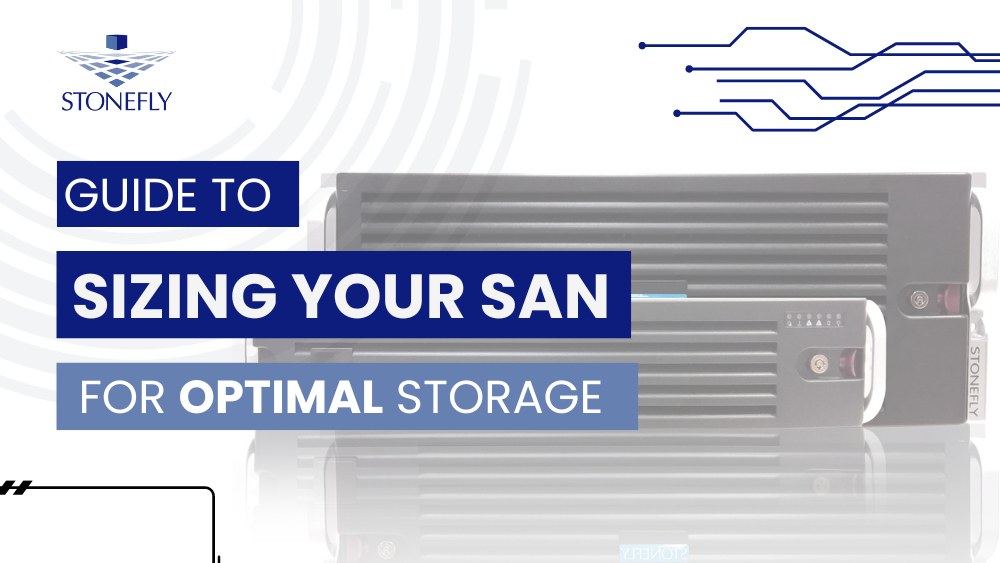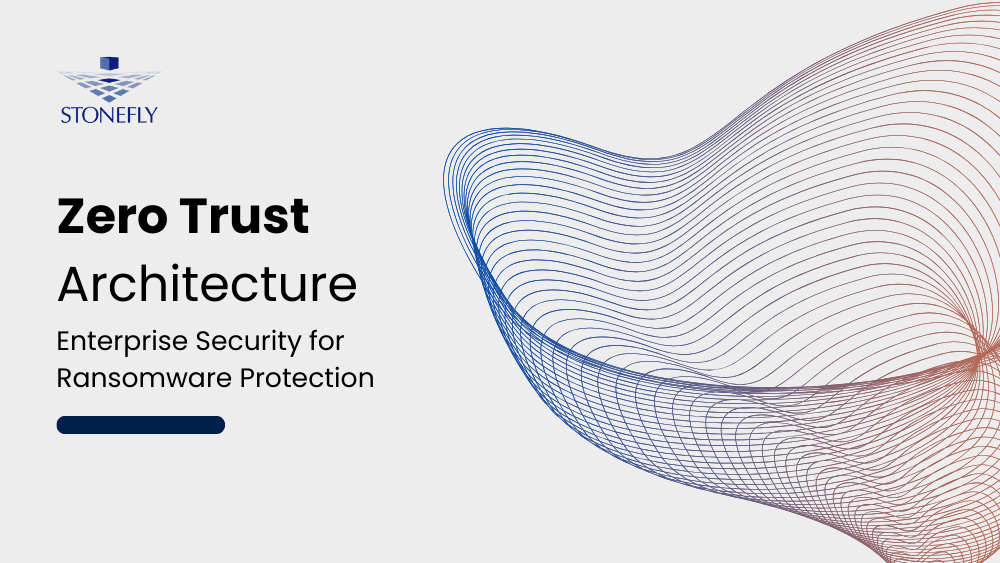In today’s data-driven business world, having a reliable and scalable enterprise data storage solution is crucial. As businesses continue to generate massive amounts of data, they need storage systems that can keep up with their growing needs, while also ensuring the security and accessibility of their data. This is where StoneFly’s SAN storage appliance comes in.
StoneFly’s SAN storage appliance offers a wide range of benefits for businesses, including high performance, scalability, data protection, and cost-effectiveness. With its advanced features and flexible design, it provides an ideal solution for businesses looking to manage their data more efficiently.
In this blog, we will explore the key factors to consider when sizing a SAN storage appliance for your business, including storage capacity, CPU, and system memory specifications. We’ll also provide tips and best practices to help you optimize your storage environment and get the most out of your SAN storage appliance. By the end of this blog, you’ll have a better understanding of how to choose the right storage solution for your business needs.
Sizing Your SAN Storage Appliance
Sizing a SAN storage appliance is a critical process for any enterprise that wants to ensure optimal storage utilization and avoid overprovisioning or underprovisioning. By following a few key steps, IT managers can accurately determine the right size of SAN storage appliance for their organization’s needs.
Identify Data Types and Growth Rate
The first step in sizing a SAN storage appliance is to determine the types of data that will be stored and the expected growth rate. This information will be useful in calculating the required storage capacity and other hardware specifications. Some data types, such as video or large image files, require more storage space than text documents or spreadsheets. Additionally, the rate at which data grows will help determine how quickly the storage capacity needs will increase.
Calculate Storage Capacity Needs
Once you have identified the data types and growth rate, you can calculate the required storage capacity needs. One way to do this is to use data storage calculators that take into account the size and number of files to be stored. Another approach is to estimate the storage needs based on past data growth rates. It’s also important to consider overhead when calculating storage capacity, as some amount of storage is required for system files, file system overhead, and RAID configurations.
Consider Scalability
When choosing a SAN storage appliance, it’s essential to consider scalability. While your current storage capacity needs may be relatively modest, you need to think about future growth and how the storage appliance will accommodate it. It’s advisable to choose a storage appliance that can be easily scaled up to meet future storage requirements.
By following these steps, IT managers can accurately size a SAN storage appliance and avoid underprovisioning or overprovisioning.
CPU and System Memory Specifications of Enterprise SAN Storage
When it comes to sizing a SAN storage appliance, it’s not just about storage capacity, but also the CPU and system memory specifications. These factors play a crucial role in determining the overall performance of the SAN storage appliance. In this section, we’ll discuss the importance of CPU and system memory and offer tips on how to determine the appropriate specifications for your workload and usage.
The CPU and system memory specifications affect the performance of the SAN storage appliance in several ways. The CPU determines how quickly the SAN storage appliance can process data, while the system memory determines how much data the appliance can store in memory for quick access. Inadequate CPU and system memory specifications can lead to slow performance and system crashes.
How to Determine the Appropriate CPU and System Memory Specifications for a SAN Storage Appliance Based on Workload and Usage
To determine the appropriate CPU and system memory specifications for your SAN storage appliance, consider the workload and usage. Here are some tips to help you:
- Determine the workload of your SAN storage appliance: Is it a high-usage system that handles a large volume of data or a low-usage system that handles smaller amounts of data? This will help you determine the appropriate CPU and system memory specifications.
- Check the system requirements of the applications that will be running on the SAN storage appliance: Some applications require a minimum amount of CPU and system memory to run efficiently. Check the system requirements of the applications you plan to run on the SAN storage appliance and ensure that the CPU and system memory specifications meet the requirements.
- Consider the growth rate of your data: As your data grows, the performance of the SAN storage appliance can suffer. Consider the growth rate of your data and ensure that the CPU and system memory specifications can handle the growth.
- Consult with a storage expert: If you’re unsure about the appropriate CPU and system memory specifications for your SAN storage appliance, consult with a storage expert who can help you determine the right specifications for your workload and usage.
By following these tips, you can ensure that your SAN storage appliance has the appropriate CPU and system memory specifications to handle your workload and usage.
Data Protection and Disaster Recovery for Enterprise SAN Storage Solutions
Data protection and disaster recovery are crucial for businesses that rely on enterprise data storage solutions. In this section, we’ll discuss how StoneFly’s SAN storage appliance offers data protection and disaster recovery features to help businesses maintain their critical data.
Redundant Array of Independent Disk (RAID) for Data Protection
StoneFly’s SAN storage appliance offers various RAID options to protect data against hardware failures. RAID 1, for example, creates a mirrored copy of the data on two or more drives, ensuring that the data remains accessible even if one of the drives fails. RAID 5 and 6 use distributed parity to protect data against a single drive failure, while RAID 10 combines mirroring and striping for both redundancy and performance benefits.
Depending on the appliance model and series, StoneFly SAN storage appliances can support RAID 0, 1, 3, 5, 6, 10, 30, 50, and 60.
Optional Backup and Restore Options for Disaster Recovery
In addition to RAID options, StoneFly’s SAN storage appliance provides various backup and restore options for disaster recovery purposes. The appliance supports a variety of optional backup protocols, including NDMP, iSCSI, and SMB/CIFS. Users can also take advantage of snapshot and replication features to create copies of data for backup or disaster recovery purposes.
Choosing the Right Data Protection and Disaster Recovery Features
Choosing the appropriate data protection and disaster recovery features depends on various factors, including business needs and regulatory requirements. For example, if a business needs to comply with specific regulations or standards, such as HIPAA or PCI DSS, they may need to implement additional data protection and disaster recovery measures.
Businesses should also consider the RPO (Recovery Point Objective) and RTO (Recovery Time Objective) when selecting data protection and disaster recovery features. The RPO refers to the maximum allowable amount of data loss in the event of a disaster, while the RTO refers to the maximum allowable time for data restoration.
StoneFly’s SAN storage appliance offers various data protection and disaster recovery features to meet the needs of businesses of all sizes. With the appliance’s RAID options, backup and restore options, and snapshot and replication features, businesses can ensure the safety and availability of their critical data.
Cost Considerations of Enterprise SAN Storage Solutions
As businesses evaluate their options for enterprise data storage solutions, cost is one of the most important factors to consider. In this section, we will discuss the various cost considerations that businesses should keep in mind when choosing a SAN storage appliance.
Upfront Costs
The upfront cost of a SAN storage appliance is the initial investment required to purchase the hardware and software. This cost can vary significantly depending on the capacity and features of the appliance.
Ongoing Maintenance Costs
In addition to upfront costs, businesses must also consider ongoing maintenance costs. These costs include software updates, hardware repairs or replacements, and ongoing support from the vendor. It’s important to choose a vendor that offers reasonable ongoing maintenance costs to ensure that the total cost of ownership remains manageable over the lifespan of the appliance.
Total Cost of Ownership
To evaluate the total cost of ownership of a SAN storage appliance, businesses must consider both the upfront and ongoing maintenance costs. They should also factor in any savings that the appliance may offer in terms of reduced downtime, improved performance, or streamlined data management processes.
Tips for Evaluating Total Cost of Ownership
To evaluate the total cost of ownership of a SAN storage appliance, businesses should consider the following tips:
- Consider the lifespan of the appliance: A SAN storage appliance typically has a lifespan of several years, so it’s important to consider the ongoing maintenance costs over this period.
- Factor in any savings: Consider any potential savings that the appliance may offer, such as reduced downtime, improved performance, or streamlined data management processes.
- Look beyond upfront costs: While upfront costs are important, they should not be the only factor considered. Ongoing maintenance costs can add up over time and have a significant impact on the total cost of ownership.
By considering these cost considerations and tips, businesses can make an informed decision when choosing a SAN storage appliance that meets their needs and budget.
Conclusion
In conclusion, by considering factors such as workload, data types, and data growth rate, you can accurately size your SAN storage appliance to meet your business needs.
Additionally, selecting the appropriate CPU and system memory specifications and data protection and disaster recovery features is crucial to optimizing performance and protecting your data from potential risks. And, of course, it’s essential to keep in mind the various cost considerations associated with SAN storage appliances.
At StoneFly, we offer a range of SAN storage appliances that can be customized to fit your specific needs. Our team of experts is always available to help you evaluate your options and choose the right solution for your business. Contact us today to learn more about our SAN storage appliances and how we can help you optimize your enterprise data storage.







